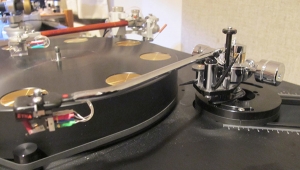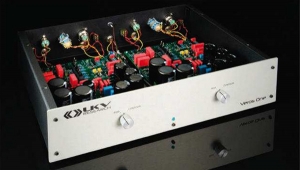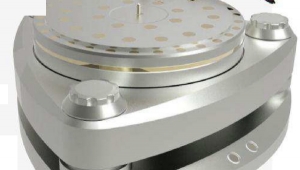| Columns Retired Columns & Blogs |
Analog Corner #267: Reed Muse 3C turntable & Reed 3P tonearm

The Reed 3P tonearm, which I reviewed in my April 2016 column, was an impressive piece of imaginative engineering and manufacturing prowess. I asked Reed's importer, Axiss Audio, if I could hold on to the 3P—I was already planning to review Reed's Muse 3C turntable. I'm glad I did—the 3P ($5000) and 3C ($15,000) make an outstanding combination. (When the only complaint you have about a turntable is that the cable from its power jack to the power supply isn't long enough to reach the floor, you can be sure you're going to write a very positive review.)
Footnote 1: Reed, Tonearms.lt, UAB, Kauno r. sav. Naujojo Munišklu k., jmones kodas 302555039, PVM moketojo kodas LT100005697918, Lithuania. Tel: (370) 6863-5272. Web: www.reed.lt. US distributor: Axiss Audio, 17800 S. Main Street, Suite 109. Gardena, CA 90248. Tel: (310) 329-0187. Web: www.axissaudio.com
Reed, based in Lithuania (footnote 1), has been designing and manufacturing analog products for almost a decade. The Muse 3C is among the best-looking turntables I've reviewed—with its swept-wing styling, dominated by a large, cylindrical platter housing, the basic look reminds me of Sperling-Audio's L-1 turntable, which I reviewed in my August 2015 column. Each wing ends in a large-diameter tonearm pod topped by an aluminum disc that can be rotated to accommodate tonearms from 9.5" to 12" long. On the left wing are three large, square pushbuttons: 45, 33, and 0.
The 9lb platter appears to be made of polyoxymethylene (aka POM or Delrin), and is fitted with a machined aluminum insert that receives the subplatter's tapered spindle, and a peripheral aluminum ring that adds rotational inertia. This assemblage rotates on an inverted ball bearing "made either from steel or ceramics," whatever that means, with axial support provided by a "very durable and low-noise polymer sliding bearing," also per Reed. An attractive record mat of gray leather, branded "Reed," is supplied.
An interesting feature of the 3C is its built-in strobe system. Start the platter spinning, and a series of circular openings around the platter's periphery glow green and stabilize within a split second, indicating that it's reached the correct speed. When you hit "0," to stop the platter, the green glow continues for a while, then goes dark. The platter stops about as quickly as it starts.
Easy Setup
Reed includes instructions and photos for unpacking and packing the Muse 3C. Every turntable manual should include these! Even without its platter, the Muse 3C weighs 55lb, so lift with caution when placing it on your turntable stand. (My stand is a Harmonic Resolution Systems SXR system with an oversize granite platform fitted with six isolation bars.)

The Muse 3C with platter removed, in friction-drive mode.
The 3C's large, switch-mode power supply is a 12–13.2V BOTW (Best of Two Worlds) P&P ECO from Sbooster, a Netherlands company that specializes in power-supply upgrades for audiophile DACs, headphone amps, etc (footnote 2). I found this supply for $375 on Amazon. I think it was smart of Reed to use a high-quality, off-the-shelf supply and not hide it in a fancy aluminum box that would only raise the 3C's price. Of course, if you buy a 3C and want to play around, you might be able to run it on batteries and perhaps hear a improvement in the sound. I didn't try that.
The 3C also includes Reed's built-in "inclinometer." Rather than automatically level the turntable, a series of LEDs shows you where it's tilting. You then adjust the feet until all four LEDs go dark, indicating that the 3C is perfectly level. This is not the easiest thing to do with a 55+lb turntable—it's best to place it on a perfectly level surface to begin with. That done—and you've installed and set up your tonearm—it's time to spin records.
Unique Dual Drive System
Do you prefer a friction-drive—ie, idler-wheel—turntable? Then you'll be happy with the 3C. Or are you a belt-drive guy or gal? You, too, will be happy. The Muse 3C can be ordered either way—or, for slightly more money, with both drive options.
The heart of the 3C's unique drive mechanism is its system of two opposed DC motors, controlled by a quartz-based phase-locked loop (PLL) circuit, that drive the platter with friction rollers—these propel the platter as would an idler wheel, although the rollers are themselves motorized as opposed to being passive, intermediary devices—of different diameters, and that turn at different velocities. To eliminate "beat"-caused vibrations, the rollers have diameters that are not multiples of each other. This concept reminded me of the belts of differing flexures used to prevent "beating" in Döhmann's Helix 1 turntable, which I reviewed in my March 2017 column. Changing from roller drive to belt drive is a simple procedure in which you replace the friction rollers with belt pulleys, add the belt, and flip a toggle switch that, like the drive mechanism, is exposed when the platter is removed.
With Friction Drive
The Reed Muse 3C came with the dual friction drive already set up, so that's how I first listened to it, with Grado Labs' new Lineage Epoch cartridge ($12,000, reviewed in December 2017) installed in Reed's 3P tonearm. The combination proved so agreeable and engaging that I left the Epoch on the 3P for the entire review, though I did mount both the Wand—a relatively inexpensive carbon-fiber arm made by Design Build Listen Ltd. of Dunedin, New Zealand—and the Mørch DP-8 on the Reed's second arm pod. The Mørch, which I reviewed in my April 2016 column, had originally been sent with an armtube of the wrong mass for the cartridges I regularly use. The importer sent the correct armtube a while back, but I hadn't had a chance to use it till now—Reed kindly machined for me arm mounts for both Wand and Mørch.
The Muse 3C with 3P arm comprises a most agreeable- and enjoyable-sounding record player. It produced impressively "black" backgrounds, and every record I played made it clear that the 3C had great drive and authoritative speed stability. Dr. Feickert Analogue's PlatterSpeed app confirmed that the 3C ran precisely at 33.33 and 45rpm, with only minor variations of speed. Look at the excellent numbers in figs.1 and 2. That's what you'll hear. Swapping tonearms and cartridges (other than the Epoch on the 3P) demonstrated that the 3C was, essentially, tonally neutral—the characteristic sound of each of my familiar cartridges and somewhat less familiar tonearms came through clearly.

Fig.1 Reed Muse 3C, speed stability data, friction drive, Fig.2 Reed Muse 3C, speed stability, friction drive (raw frequency yellow; low-pass filtered frequency green).
As I wrote in April 2016, in my review of the 3P arm, its "overall tonal balance was neutral to a bit sweet, particularly in the midrange, without the sound growing a midband bubble or transients losing their natural edge. Was that sweet midrange the result of the Brazilwood? Maybe: I didn't measure. Bass was nimble, clean, and well extended, though it didn't quite match the Kuzma 4Point's iron-fisted authority in the lows. (I'm not comparing anything to the Swedish Analog Technologies arm.) On the other hand, the 3P's midrange will surely appeal to those who, unlike me, find the 4Point somewhat austere in that region."
The Grado Lineage Epoch itself leans toward a slightly sweet midrange, but the combination of the two didn't lean too far. Instead, it produced a well-detailed yet lush, airy midrange with nimble bass and a naturally expansive top end that worked well for all types of music, especially jazz and classical. Transients were notably clean, natural, and fast, without even a hint of etch or edge.

Last July, at the 2017 Thailand International High-End Audio-Video Show, in Bangkok, I encountered a record dealer who specialized in Japanese animé on vinyl (footnote 3). A reader suggested I buy Dragon Quest III: Symphonic Suite (2 LPs, ALTY AY 30-1-2). This costly, three-sided, two-LP set from the1980s is the soundtrack to a video game, but I took a chance. Glad I did! The symphonic score, composed and conducted by Koichi Sugiyama (now 86) and performed by the NHK Symphony Orchestra, is a superbly recorded, fascinating amalgam of Bach, Mahler, and maybe some Max Steiner.
Footnote 1: Reed, Tonearms.lt, UAB, Kauno r. sav. Naujojo Munišklu k., jmones kodas 302555039, PVM moketojo kodas LT100005697918, Lithuania. Tel: (370) 6863-5272. Web: www.reed.lt. US distributor: Axiss Audio, 17800 S. Main Street, Suite 109. Gardena, CA 90248. Tel: (310) 329-0187. Web: www.axissaudio.com
Footnote 2: You can read more about this interesting company and its products at www.sbooster.com, and you should. They offer power supplies for a wide range of audio brands, almost all of which will be familiar to you and some of which you probably own.
Footnote 3: Watch me flip through his LPs here.
- Log in or register to post comments




































